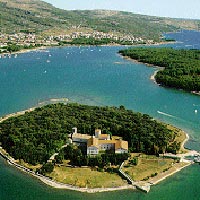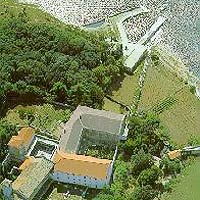Cultural heritage
- The little church of St. Dunat from the 9th century, at the Dunat site ahead of the intersection where you turn for Punat.
- Finds of the little church of St. Peter from the 6th century at the Kanajt site, only 30 m above the hotel bearing the same name.
- The reconstructed little church of St. George from the 13th century at the Mala Krasa site, near the promenade running from Punat toward the Konobe Naturist Camp.
- The partially reconstructed little church of St. Jerome at a site above the Zala cove in Stara Baška.
- Excavations of a military complex at the Mir site above the Surbova cove in Stara Baška.
- The Way of the Cross above Punat, at the Tri križi site on the way to Kalabrinj, within the pedestrian paths.
Franciscan Monastery Košljun
 Only 750 meters from Punat lies the islet of Košljun. It is known for the Franciscan monastery where the monks have collected and preserved numerous valuable items for centuries. The islet has a museum with an ethnographic collection containing numerous items produced by Krk fishermen and farmers, as well as folk costumes from across the Island of Krk. The monastery also owns a rich zoological collection consisting of a large seashell collection and unique animal specimens, such as the one-eyed lamb. The monastery also has a rich library with around 30,000 titles. It includes the Ptolemy’s atlas printed in Venice in 1511 (one of the three preserved copies). The monastery is a zero category monument. There are two churches on the islet – the Church of Blessed Virgin Mary’s Annunciation and the Church of St. Bernard.
Only 750 meters from Punat lies the islet of Košljun. It is known for the Franciscan monastery where the monks have collected and preserved numerous valuable items for centuries. The islet has a museum with an ethnographic collection containing numerous items produced by Krk fishermen and farmers, as well as folk costumes from across the Island of Krk. The monastery also owns a rich zoological collection consisting of a large seashell collection and unique animal specimens, such as the one-eyed lamb. The monastery also has a rich library with around 30,000 titles. It includes the Ptolemy’s atlas printed in Venice in 1511 (one of the three preserved copies). The monastery is a zero category monument. There are two churches on the islet – the Church of Blessed Virgin Mary’s Annunciation and the Church of St. Bernard.
It takes around two hours to see the whole islet, but there are no catering facilities there.
The history of Košljun
 According to the archeological finds, the history of Košljun dates back to the pre-Christian times. The historical significance of Košljun became more notable after the establishment of the Benedictine abbey in the 11th century. The shrine of St. Mary of Košljun on Mostir became a source of freshness to the religious, cultural and national life of the Island of Krk and the surrounding area.
According to the archeological finds, the history of Košljun dates back to the pre-Christian times. The historical significance of Košljun became more notable after the establishment of the Benedictine abbey in the 11th century. The shrine of St. Mary of Košljun on Mostir became a source of freshness to the religious, cultural and national life of the Island of Krk and the surrounding area.
When the Franciscans came, they gave a new upswing to the religious, cultural and national activities on Košljun. In the 15th century, they took over the ruinous Benedictine «Mostir» and built a monastery according to the instructions provided by St. Bernard of Siena, a Franciscan reformist. His idea was to renovate the Church and Europe in the spirit of Francis of Assisi. He requested of his followers to move from the urban centers into the suburbs. They would better build themselves spiritually here, and then convey the values acquired to the people by preaching and by own example, in the quiet of the monastery. Košljun, a suburb to the Town of Krk, was a godsend for such an idea.
The ‘’Franciscan Košljun’’ was actually created at the time of the decline of Istanbul. The Turks occupied our regions (Lika, Krbava). Venice took over the North Adriatic islands. Print was invented at the same time (the last, 1282nd page of the Bible was printed in 1455).
Domestic dukes took over reign of Krk in the 11th century. They successfully expanded their reign to a part of Istria, through Gorski kotar and all the way to Bosiljevo toward Lika and Krbava. Later referred to as the Frankopans (Frankapans), they enabled the arrival of the Franciscans on Košljun. The Franciscans were in the Town of Krk as early as the 13th century. Ivan VII and his brother Martin (Frankopan) received a permit from Pope Nicholas V (the bull is in the monastery archive) for the Franciscans to take over the worn out «Mostir» Košljun in 1447. Reconstruction began with the help (1000 ducats) from Ivan Frankopan. Afterwards, his daughter Katarina who married in Venice left another 1000 ducats in her will. The large amount at the time was provided on the condition that she be buried on Košljun, in the ‘’land of her forefathers’’. Her grave with the original tombstone is situated next to the entrance to the present church. In 1480, Venice took over the Island of Krk by diplomatic tricks and imposture. Difficulties arose with implementation of Katarina’s will. She died in 1520, and was not transferred to Košljun until 1529.
The 1991 excavations discovered the foundations of the former three-nave Church of St. Mary beneath the pavement of the present church. The present south wall of the church is partially a wall of the former Benedictine church. The door to their monastery is still visible on it. The roof beams of the present church are decorated with original drawings of the Frankopan family crests. In the early 18th century, the church was converted to the baroque style. The first century of the present church was marked by the polyptych made by Girolamo da s. Croce (1535). As customary at the time, he eternalized the donors – Katarina and Ivan Frankopan – in the image of St. Catherine and John the Baptist. Between them was the guardian of the town of Krk: St. Quirinus, the first bishop of Sisak.
The 17th century was marked by a work of F. Ughetto – The Divine Kingdom – presenting heaven, purgatory and hell. Unusually large dimensions for oil on canvas (1653). The lateral altar-pieces Petar Alkantarski (F.Jurić) and Karlo Boromejski (B.Gianelli) – left side of the church, 18th century. They display that Košljun followed the spiritual and scientific movements of the European West. The Franciscan Josip Rossi presented the 19th century by his painting of St. Diego (1860). Ivo Dulčić (1960) presented our 20th century by the wonderful "Way of the Cross".
The spiritual and cultural significance of Košljun over the past five centuries has been recorded by artists’ paintbrushes in the paintings arranged by century, illustrating Košljun as a sort of a TV repeater. It has registered the spiritual and cultural movements of the European West and directed them to its own area of activity. If the radiation is negative, it opposes it. In the last century, after Italy was united, liberalism began to spread. Future totalitarianisms began to arise. In Istria and on Kvarner islands, the Croats and Slovenians (the majority peoples) were allowed to attend secondary school in their mother tongues. Istria futilely requested license to establish a Croatian gymnasium in Pazin for 25 years. Košljun obtained the license privately in Vienna, and established a Croatian gymnasium in 1894, the first one on the territory of Istria and Kvarner islands. Remains of the various collections of the gymnasium and other schooling aids can be found at the cloister from the early 17th century or the ethnographic museum. The cloister leads to the Church of St. Bernardin. It was built within the Frankopan tower and converted into a sacral museum. The numerous exhibits include the Bible text from the 11th century (a parchment roll in Hebrew). You can also find the original or revised editions of the oldest Glagolitic books or manuscripts, two copies of the ninety incunabula at the monastery library (over 30,000 volumes) and two parchments from the rich monastery music library (Neumas from the 11th century).
The wooden triptych of St. Bernardin (15th century). The collection of sacral items from the ‘’golden’’ age of Krk’s sacral fraternities. The distinctive Košljun crucifix (16th century) and a rare specimen of the crucifix from the transitional era of displaying Jesus on the Cross (12th century). At first, Jesus was illustrated as a victor over death on a cross with a royal crown. From the 3rd century, illustration of his immeasurable love for man prevailed. This love made him sacrifice his life on the cross, which is why they display suffering, pain and crucifying. The exhibited crucifix (12th century) displays the characteristics of the transitional period.
The Košljun ethnographic museum enables a view into the life on the Island of Krk in recent past – boat models, wooden household tableware, farming tools, cheese making equipment, musical instruments – sopile, equipment for the wool and weaving industries, a folk costume, ceramics... In addition, there is a rich numismatic collection, and Ptolemy’s (1511) and Strabo’s (1573) atlases.
In the middle of a thick forest (holm oak - Quercus ilex) you will find the following chapels: Birth (1651) and St. Cross ("Jerusolim") from 1579; The death of St. Francis, 1654, hand decorated by the academic painter Bruno Bulić, a lover of Košljun. The silhouette of St. Francis on the shore is his work. He is taming a Gubian wealthy man’s ‘’brother wolf’’.
The Benedictines presented Košljun under the motto: PRAY AND WORK. You will encounter it on the front door of the monastery, while the Franciscan PEACE AND GOOD salute will see you out – written, of course, in the Glagolitic script!
